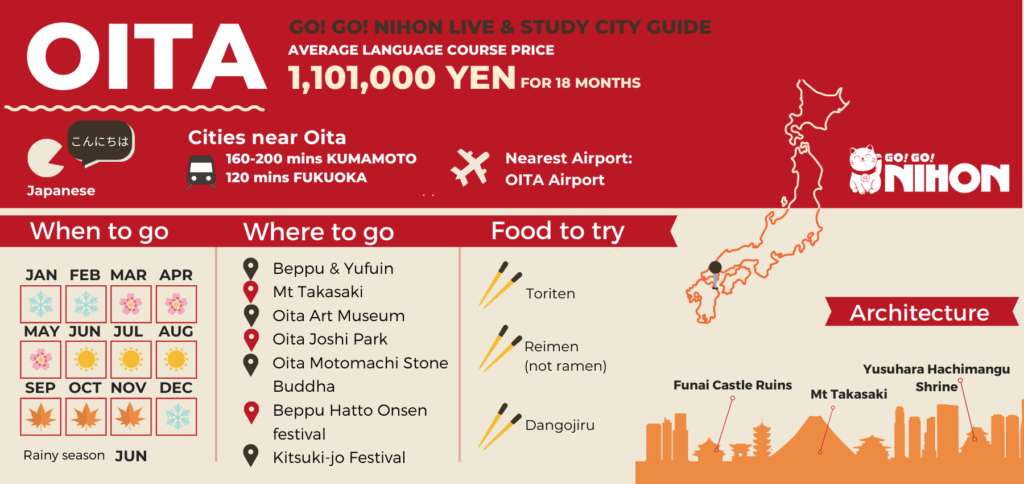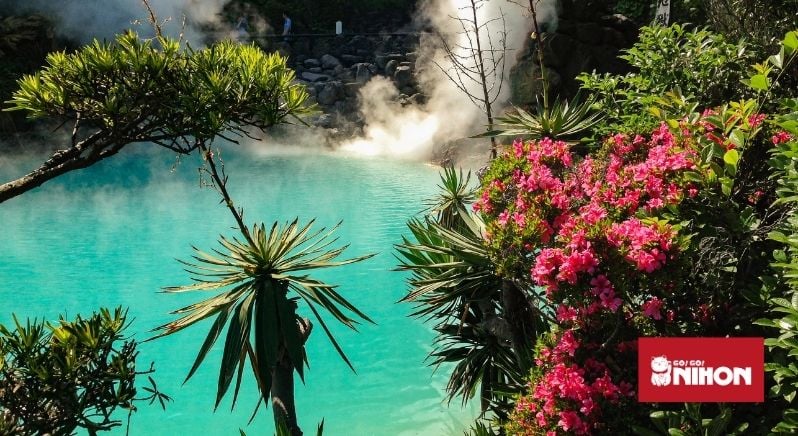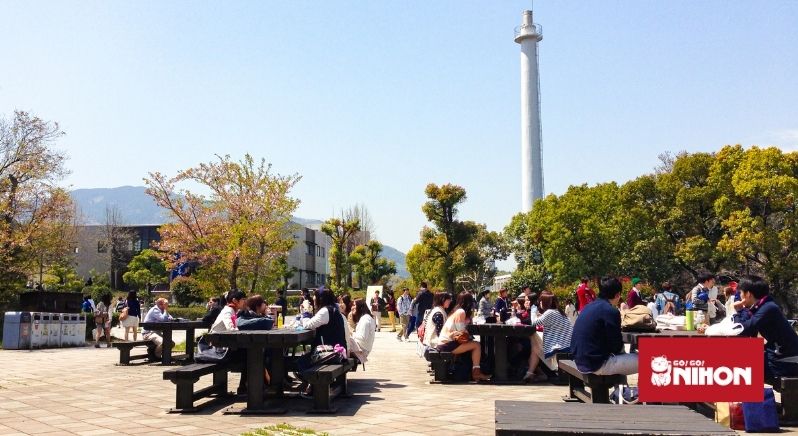Oita prefecture (Ōita-ken 大分県) is located on the island of Kyūshū 九州 and is famous for its thousands of hot springs (onsen 温泉) and it’s unspoiled nature. If you think you want to live in Oita and immerse yourself in its mountains, coastlines and green fields, then read on to learn more about the region!

Places to visit in Oita Prefecture
Oita prefecture is a great gateway to the rest of the island, with Fukuoka 福岡, the capital of Kyūshū, just a couple of hours away by train. Other parts of Kyūshū, including the subtropical island of Yakushima 屋久島, the port city of Nagasaki 長崎 and many other places are accessible from Oita via train, bus, airplane and car.
However, Oita itself is abundant with places to visit. Let’s take a look at some of the top destinations that you could visit if you live in Oita.
A mix of east and west in Oita City
Oita city is the coastal capital of Oita prefecture and was once a gateway to the western world. As a result, you’ll find touches of European influences and a strong Christian history.
During the 16th century, many people who lived in Oita converted to Christianity after the feudal lord ruling at the time became a Roman Catholic. However, Christianity was prohibited the following century, which forced many to renounce their beliefs or practise their faith in hiding. Some 200 people refused to give up their religion and died as martyrs instead – their unwavering faith remembered in a Christian Martyrs Memorial Park.
Other attractions in this city include the city’s art museums, aquarium, monkey park, castle ruins and the Oita Motomachi Stone Buddha, which features centuries-old Buddha figures carved into rock face.

Dip into onsen heaven in Beppu 別府
Beppu is the onsen capital of Japan, with a variety of steaming and bubbling hot springs to help you relax. For those who want to try something different, there are also sand, mud and steam baths.
If you just want to observe a beautiful, boiling hot, landscape you can visit Jigoku 地獄, or “hells”. These consist of seven hot springs that include boiling mud pools and steaming pools of different colours for you to observe.
Locals here have really harnessed the thermal energy and even use it to cook food. Jigoku mushi 地獄蒸し is a method of steaming food using the natural steam from the hot springs. You can visit a place called Jigokumushi Kōbō Kannawa 地獄蒸し工房鉄輪, which is a cooking centre where you can rent steam cookers. Just bring your own food, pay, steam and enjoy.
Each year in March, Beppu puts on the Hatto Onsen Festival to celebrate its onsen culture. It’s held over four days and every day features a different activity and event.
Aside from onsen, there are also scenic hikes to enjoy. Or if you can’t get enough, there’s nearby Yufuin 由布院, a rural onsen town that’s popular as a day trip and an escape from the bigger city.
Read more about Japan’s onsen culture and etiquette here.
Study in Beppu
Go! Go! Nihon partners with Beppu-based Ritsumeikan Asia Pacific University. Through their E-track program, you can access three of their degree courses in English, while learning Japanese in a multicultural environment at the same time. These degrees are the Bachelor of Business Administration, Bachelor of Social Science, and Bachelor of Sustainability and Tourism.
Read more about this university on our website.
A rural and spiritual escape to Kunisaki Peninsula
Kunisaki Hantō 国東半島 is home to a unique religious group, Rokugo-Manzan 六郷満山 that fuses Buddhist, Taoist, Shinto and folk beliefs. It centres around the peninsula’s numerous mountain temples and Usa Shrine. Usa Jingū 宇佐神宮 is dedicated to the Buddhist god of archery and war, Hachiman 八幡, and it is the head shrine of all the shrines dedicated across Japan to this god.
At the heart of Kunisaki Peninsula is Mt Futago (Futagosan 両子山) and on its slopes you can find Futago temple, the central temple of Rokugo Manzan.
To the south of the peninsula lies Kitsuki 杵築, a well-preserved samurai town that features some samurai residences that the public can visit. They have even gone to the effort of keeping the place devoid of power lines to give it a more authentic feel. Each year this town puts on the Kitsuki-jo Festival to celebrate its history as a samurai town, featuring Edo-era costumes and a parade.
Local cuisine
Like most other places in Japan, Oita is abundant in fresh seafood. But the people of this prefecture are said to eat more chicken than anywhere else in Japan. The two most popular dishes are toriten とり天, which is chicken tempura, and karaage からあげ, deep fried chicken. The chicken tempura is often served with mustard and ponzu ポン酢, a citrus-based soy sauce.
A famous noodle dish in this area is reimen 冷麺, which is a cold noodle dish consisting of soba buckwheat noodles served with half a boiled egg, kimchi-like spicy and sour cabbage, sliced roast beef, spring onions and sesame seeds.
Another popular noodle dish is dangojiru だんご汁. The word “dango” means dumpling and they’re usually round and made out of sticky rice. But in this dish, the dango is stretched out into noodles and served with a miso-based soup and vegetables. The prefecture is particularly known for its shiitake mushrooms, so you can always expect to find them in this dish.
Read more about different types of noodles in Japan here!

Why live in Oita?
One of the top reasons to live in Oita as a language student is that the prefecture has one of the highest ratios of foreign students to Japanese students. This is thanks to Oita University and Ritsumeikan Asia Pacific University, which is one of the top international private education institutions in Japan. The latter has around a 50-50 ratio of local and international students.
This means you’ll get to know people from all over the world, as well as from Japan. Plus, it’ll be the perfect place to continue studying if your plan is to continue with further education after finishing language school.
You’ll also get all the benefits of living in a smaller city in Japan: the lower cost of living compared with the larger cities, friendlier locals and more opportunities to practise your Japanese.
If you’re curious about living and studying in Oita, contact us today to connect with our team.
Still unsure about where you should study in Japan? Take our quiz!














